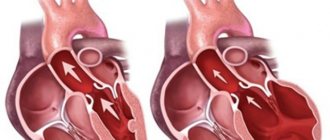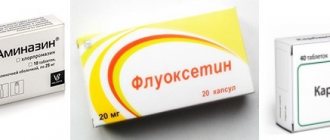Agnosia is a violation of some forms of the body’s perception of information (auditory, visual, tactile). At the same time, consciousness and sensitivity are preserved. The ability to recognize is also lost due to dysfunction of the cerebral cortex.
There are different types of agnosia:
- Visual.
- Spatial.
- Auditory.
- Somatoagnosia.
Spatial agnosia is characterized by loss of the ability to navigate in space. Patients cannot determine the location of an object, distance, direction to the object, its configuration and geometric shapes. Patients suffering from this disease are unable to find their way back if they leave home unaccompanied.
Spatial agnosia is a persistent and progressive disorder that usually occurs when the cerebral cortex is damaged in the parieto-occipital region. In this case, recognition is impaired according to various criteria:
- Topographical - when there is disorientation in space, even if the patient is well aware of his location. Such patients are capable of getting lost in their own home, on the street, in the yard. It is characteristic that the memory is preserved quite clearly.
- Spatial one-sided - characterized by the loss of one of the spatial halves, usually the left, from the field of perception. In this case, the side opposite to the prolapsed side, the parietal lobe, is affected.
- Three-dimensional vision impairment occurs when the left hemisphere of the brain is damaged.
- Depth agnosia is when the ability to correctly localize seen objects in three spatial coordinates, especially in depth, is impaired. Characteristic of lesions in the middle part of the parieto-occipital region of the brain.
Patients with spatial agnosia also cannot determine the time by the location of the hands on the clock and are unable to read geographic maps. When the drawing is redrawn, such patients display only half of the image.
Features of agnosia
Visual agnosia is expressed in the fact that a person ceases to recognize certain objects and things, although visual function is not impaired (object agnosia). The patient can easily describe the properties of an object, its part, but is not able to name the object itself. Or it happens that the patient is not able to recognize the faces of people he knows well (prosopagnosia).
The patient can easily name individual parts of the face, but cannot find out whose it is. In particularly difficult cases, patients are unable to recognize their own reflection in the mirror. Color agnosia is expressed in the patient’s inability to correctly select the same colors or their shades. Cannot match or associate any color with a specific object.
With simultaneous agnosia, the visual field is narrowed to a single object. In this case, the patient is able to see and evaluate a single specific object. Also, with visual agnosia, there is a weakness of optical representations, when the patient cannot imagine a certain object, as well as describe it in size, shape, color.
Such a concept as Balint's syndrome is characterized by the patient's inability to direct and fix his gaze in a certain direction. Such patients cannot focus and hold their gaze on any object. Reading in this case is simply impossible for such patients.
Auditory agnosia consists of impaired perception of various sounds and speech. Patients cannot correctly recognize simple sounds (knocking, ringing, rustling, gurgling water) with simple auditory agnosia.
With auditory-verbal agnosia, patients perceive the human voice and speech as a set of sounds devoid of any meaning. Tonal agnosia is expressed in a clear understanding of the meaning of what was said, but there is a violation in determining the tone and timbre of the voice, the emotional coloring of what was said.
There is also somatoagnosia, which comes in two types:
- Anosognosia is when patients deny the presence of a disease, even if the disease is very clearly expressed.
- Autopagnosia - when patients forget about half of their own body and do not use this half. Such patients are unable to determine the number of their own limbs, their posture or the position of individual parts of the body. It seems to them that this half belongs to another person, that there are more arms or legs, etc.
Simultaneous agnosia occurs with bilateral or right-sided damage to the occipital-parietal parts of the brain. The essence of this phenomenon in its extreme expression is the impossibility of simultaneous perception of several visual objects or a situation in a complex. Only one object is perceived, or more precisely, only one operational unit of visual information is processed, which is currently the object of the patient’s attention. For example, in the task “put a dot in the center of the circle,” the patient’s failure is revealed, since the simultaneous perception of three objects in interconnection is required: the outline of the circle, the center of its area and the tip of the pencil. The patient “sees” only one of them. Simultaneous agnosia does not always have such a clear expression. In some cases, only difficulties are observed in the simultaneous perception of a complex of elements with the loss of any details or fragments. These difficulties can manifest themselves when reading, when sketching, or when drawing independently. Often, simultaneous agnosia is accompanied by disturbances in eye movements (gaze ataxia).
Unilateral damage to the left occipito-parietal region can lead to disruption of the perception of symbols characteristic of the language systems familiar to the patient. The ability to identify letters and numbers while maintaining their spelling is impaired ( symbolic agnosia ). It should be noted that in its pure form, letter and number agnosia is quite rare. Usually, with a wider lesion with “capture” of the parietal structures themselves with their function of spatial analysis and synthesis, not only perception is disrupted, but also the writing and copying of graphemes. However, it is important that this symptom has a left hemisphere localization.
Agnosia for faces , on the contrary, manifests itself when the right hemisphere of the brain (its middle and posterior parts) is damaged. This is a selective gnostic defect; it can occur in the absence of objective and other agnosias. The degree of its severity varies: from impaired memory of faces in special experimental tasks, through failure to recognize familiar faces or their images (photos) to failure to recognize oneself in the mirror. In addition, a selective violation of either facial gnosis itself or memory of faces is possible. What is specific about a “face” as a visual object compared to an object? It seems to us that the perception of a face, firstly, is determined by very subtle differentiations of the whole object (“a face with an unclear expression”) with the similarity of the main features (2 eyes, mouth, nose, forehead, etc.), which are usually not subject to analysis, if everything is fine in the face. The interpretation of a violation of facial gnosis due to a deficiency in the holistic perception of an object is confirmed by data on the difficulties of playing chess in patients with damage to the right hemisphere. Patients who previously played chess note that they cannot assess the situation on the chessboard as a whole, which leads to disorganization this activity. Secondly, the perception of a face always contains the contribution of the individuality of the perceiver, who sees in the face something of his own, subjective, even if these are portraits of famous people. The specificity of the perceived egg is both in its unique integrity, reflecting the individuality of the “sample”, and in the relation of the perceiver to the original. We have already spoken above about the role of the right hemisphere in direct, sensory processes, about its “semantic” function. At least for these reasons, it becomes clear that the function of face perception is damaged when the right hemisphere of the brain is damaged.
The least studied form of visual perception disorder is color agnosia . However, to date, some data have been obtained on color perception disorders with damage to the right hemisphere of the brain. They manifest themselves as difficulties in differentiating mixed colors (brown, purple, orange, pastel colors). In addition, one can note a violation of color recognition in a real object compared to the intact recognition of colors presented on individual cards.
In conclusion, the description of visual perception disorder syndromes should be said that, despite their rather subtle analysis in the clinical neuropsychological aspect, there are quite a few “blank spots” in this area, the main one of which is the identification of factors, the violation of which in local brain lesions leads to the formation of such various disorders of visual-perceptual activity.
Agnosia -previous|next- Tactile agnosia
N.K.Korsakova, L.I.Moskvichute. Clinical neuropsychology. Content.
Treatment of the disease
Spatial agnosia is characterized by loss of the ability to navigate in space. Patients cannot determine the location of an object, distance, direction to the object, its configuration and geometric shapes. Patients suffering from this disease are unable to find their way back if they leave home unaccompanied.
Treatment of spatial and other types of agnosia consists in eliminating the cause that caused damage to the cerebral cortex and its subcortical structure. Treatment of spatial agnosia is a complex and time-consuming process. The participation of a neuropsychologist and a number of other specialists is required to compensate for lost functions.
Rate this article:
(votes: 6 , average: 4.83 out of 5)
Loading...
Related posts:
- The concept of autopagnosia and its treatment
- Tactile agnosia, its types and treatment
- Characteristic features of the manifestation of simultaneous agnosia
- Features of the manifestation of visual agnosia
- Facial agnosia, its symptoms and subsequent treatment
- The treatment process for color agnosia
Optical-spatial agnosia and its types
Agnosia is said to occur when a person’s perception (visual, auditory, tactile) is impaired due to damage to the cerebral cortex, but at the same time clear consciousness and normal sensitivity are maintained.
With damage to the superior parietal and parieto-occipital areas of the cortex of both the right and left hemispheres, optical-spatial agnosia . It is in these zones that the visual, auditory, tactile and vestibular systems interact in a complex manner. The manifestations of optical-spatial agnosia are especially noticeable with bilateral lesions, but even with a lesion on one side, the disturbances are clear.
Kasperovich Anna
A person with optical-spatial agnosia cannot navigate in space (even in his own home), find a well-known road and return home. He cannot recognize the spatial characteristics of the objects that he sees, that is, he does not understand their three-dimensional model, namely the size and depth of the object, its distance (distance to the object), direction and location in relation to other objects (for example, he does not see which the object is lower and further, higher and closer), confuses right and left, top and bottom. He is not always able to count the number of objects (real and in the picture). Difficulties are also caused by determining the cardinal directions, understanding the coordinates of the area, determining one’s location on a geographic map, and a schematic representation of one’s house (room, apartment). Sometimes orientation in real (three-dimensional) space is not affected, but there are violations on paper (in two-dimensional space).
Fernando Vicente
With a lesion (or dysfunction) on the left , orientation in space (namely, schematic representations) is disrupted, that is, a person cannot mentally rotate a geometric figure in space, is not able to navigate a geographical map, a watch dial, etc. His ability to draw suffers, since he cannot convey important spatial characteristics, that is, to depict one object further or closer, larger or smaller than another, and he also cannot navigate the sides (right and left) and the pattern of the drawing (top and bottom). Sometimes the patient is unable to connect the individual parts of one object, he depicts them separately from each other (for example, when drawing a kitten, the result is not an animal, but a set of its body parts - ears, tail, paws, etc.). Despite this, the patient can still copy the drawn image. In a person with optical-spatial agnosia, the body diagram is disrupted (see Autotopagnosia), and finger agnosia also appears, when the patient cannot identify and name the fingers that are touched or pointed at.
Also, a person with optical-spatial agnosia does not understand and cannot name words with a spatial meaning (prepositions: on, under, for, above, in, etc.; adverbs: close, on the side, on top, etc.), which is why his speech is often becomes agrammatic, similar to the speech of people with semantic aphasia. In addition, with left-sided optical-spatial agnosia, reading and written speech suffer, because the simultaneous performance of actions and sound-letter analysis of words are difficult. As a rule, asymmetrical letters cause difficulties, that is, those whose right and left sides differ from each other (p, k, h, i, etc.).
An example of a technique for determining difficulties in understanding spatial prepositions from Luria’s neuropsychological album
With a lesion (or dysfunction) on the right , insufficient holistic perception of the situation and simultaneous agnosia are observed (a person cannot describe a plot picture, since he does not perceive the image as a whole, but in pieces, separate fragments, but at the same time he often recognizes individual objects and people).
An example of a plot picture from Luria’s neuropsychological album
Autotopagnosia is also observed; the patient cannot determine the location of his body parts (especially on the left), as he perceives them distortedly and disproportionately. He is unable to copy the pose that is shown to him, because he does not understand how his hands should be positioned in relation to the body (this defect is detected using the Head test. See the figure below). For the same reason, difficulties arise with everyday movements (see Apractoagnosia), which is why everyday skills suffer (the patient loses the ability to dress independently, make the bed, etc.).
Head's test
Unilateral spatial agnosia is also characteristic, when the left half of space, as well as visual, auditory and tactile stimuli on the left, are ignored. When drawing, the patient depicts an object from only one side, usually the right, without drawing the left at all or grossly distorting it.
In addition, with right hemisphere opto-spatial agnosia, the ability to recognize a familiar spatial situation is impaired, as well as to describe the situation from memory.
Right-sided lesions are much more common than left-sided ones.
Object agnosia
Object agnosia occurs when a “wide zone” of the visual analyzer is damaged and can be characterized as the absence of a recognition process or as a violation of the integrity of the perception of an object with the possible recognition of its individual features or parts. It can have varying degrees of severity - from maximum (agnosia of real objects) to minimum (difficulty recognizing contour images in noisy conditions or when superimposed on each other). As a rule, the presence of extensive object agnosia indicates bilateral damage to the occipital regions.
With unilateral lesions, the structure of visual object agnosia differs. Damage to the left hemisphere is manifested to a greater extent by a violation of the perception of objects by the type of enumeration of individual details, while the pathological process in the right hemisphere leads to the actual absence of the act of identification.








